Sailing has emerged as one of the most popular adventure sports in recent times. A quick trip to the sea is sure to soothe your mind and relieve your stress. There are many different types of boats that aspiring sailors and experienced sailing enthusiasts possess. These range from a small boat to a yacht. This begs the question- What is the largest sailboat that one person can handle? We will be discussing this in detail. So, let us begin.
SHORTHANDED
Sailing single handedly is also known as shorthanded. Though sailing becomes more fun when you have a whole crew at your disposal, some sailing enthusiasts prefer to go solo. There are many reasons for that. But the biggest dilemma a solo sailor has is choosing the right size of boat for themselves? When it comes to the size of the boat, most sailors tend to stick between thirty to thirty-five feet. Anything above fifty feet is usually uncommon.
FOOTAGE
The biggest factor affecting the size of that sailboat that one person can handle is the experience of that individual. It is a huge factor that determines the ability of an aspiring sailor to handle a large sailing boat. While a novice is just starting their journey in the sea, a seasoned sailor could easily handle a boat of any size. If you are going to dive into the world of sailing, you should have a good grasp on your basics before thinking of going single handed on a large boat.
An experienced sailor has the ability to get their hands-on-deck and get ready for any challenge that the sea throws their way. They are more use to unexpected hurdles and are better equipped to deal with them, irrespective of the size of the vessel they take to the sea. This makes experience one of the most detrimental factors when talking about the largest boat a single person can handle.
STABILITY
Another factor that has to be kept in mind is stability. The bigger the boat the more stable it is. Bigger boats can also be entirely operated from within the cockpit with the remote controls and the lines running aft. If we leave docking aside, in some ways, handling a large boat can actually be a piece of cake as compared to a smaller boat with wrong configuration.
TROUBLESHOOTING
Another factor that one should keep in mind is troubleshooting for any unforeseeable issues. While an experienced sailor may have the skills and abilities to solve most issues at sea, it is always a good idea to have more people to help when a large boat is around. Not only is it more comfortable to focus on one aspect of sailing at a time, but it also helps you in avoiding any wear and tear of the boat that can arise due to mismanagement.
HANDLING
No, we are not questioning your abilities here. The largest boat that one person can handle will have the largest sail most of the time. While it is not uncommon for a sailor to handle a sail of about three hundred to four hundred square feet; anything above that number becomes too risky, very quickly. It is very hard to handle a sail of more than that. If the weather turns quickly, you will have little time to prepare yourself and that’s the reason that the largest boat a single person can handle should have a sail in the range mentioned above.
THE SYSTEMS
If you are going to sail a large boat on your own, another thing that you need to have a clue about is the system that you would be using. If you plan to sail anything above thirty-five feet on your own, these are the systems that you should consider having in your boat.
- An autopilot for steering
- A wind vane
- Lines running aft (running to the cockpit)
- A radar
- An electric windlass
- A roller furling
- A hydraulic bow or stern thrusters with a remote
These are the systems that will help you in enjoying your time at sea. They will make sailing single handedly an easy task for you. All of these systems are vital if you want to enjoy your trip without any mishaps. They will also help in the smooth functioning of the boat.
AUTOPILOT
As mentioned above, using an autopilot system on a large boat can help a single sailor enjoy their time at sea. An autopilot system is an electric navigation system that helps sailors by steering the boat without having their hands on the wheel. They are a great add-on for sailors who like to sail single handed. They help the sailors to set anchor, adjust sails, or even have a peaceful meal without worrying about the navigation.
“Iron Mike,” “Silent Crew,” and “Otto” are some of the names that are given to the autopilot systems by sailors. They have been used in sailing for over a century and are now a vital part of sailing large boats that a single person can handle. The working of the autopilot is also pretty simple. Once the boat is heading in the right direction, the button for autopilot is pushed.
The computer then remembers the heading that is fed in it and adjusts the rudder position in order to keep the vessel on the selected course. This happens even in strong currents, high winds, or over/under steering situations. The autopilot systems usually consist of three main components. These include a course computer, which is also called a central processing unit that contains a compass, a drive unit that is used to apply the force to move the rudder, and a control unit.
IMPLICATIONS
While sailing a large boat is fun and you can enjoy the sea all by yourself, there are many things that you should keep in mind when you take your vessel on the sea all alone.
The first thing that you need to keep in mind is to not underestimate the power of the tide and the wind. The forces that you would be dealing with can become unmanageable in a quick second. You need to always be quick on your feet and have a plan ready for when things go down south. The larger the boat that you are sailing, the larger the grasp of the winds on your sails. It can become hard for you to control the vessel if the weather takes a turn for the worse.
Remember that once your large boat is in motion, it will gain momentum quickly. You will also need to make sure that you handle your boat efficiently when the tide hits it. While stopping a fifty-foot boat can be difficult, not being able to do so would be disastrous. The tide will make it difficult for you to handle your boat.
Single handed also means that if something breaks on your boat then it would be solely you who would have to manage everything. But if you are up for the challenge and are in good physical shape, you can handle all of this pretty efficiently. So, you may enjoy the feeling of taking out the vessel alone, but you should always have your backup plans ready if the sea hits you with some challenges.
To summarize, all we can say is that you should have an idea about your skills and experience before you go out to sail a large boat. Anything between twenty-five to thirty-five feet will be fine. But if you are looking for something more than that, then you should have all the systems that we have talked about. You should also have backup plans ready in case things do not go your way.
The best way to go solo is find another sailor with similar sentiments and stay in the vicinity of their boat when you go single handed. In this way, you can always enjoy your trip and also have a backup nearby. Happy Sailing!

